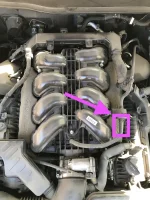MrBrady
2014 Genesis 5.0 R-Spec
- Joined
- Mar 2, 2015
- Messages
- 125
- Reaction score
- 13
- Points
- 18
- Location
- San Francisco Bay Area, California
- Genesis Model Year
- 2022
- Genesis Model Type
- Genesis GV70
Hello,
I have a 2014 Genesis 5.0 R-Spec with about 84,000 miles. I heard good things about running a GDI cleaner through it so I bought a can of CRC Intake Valve Cleaner and make sure the engine was nice and warm. Removed the vacuum line as shown in the photo and ran a hose to the inside of the car so I can spray and keep RPMs around 2,000.
There was a little bit of smoke out of the exhaust while spraying. Once the can was exhausted, I turned the car off and let it sit for an hour. When I turned it on, there was a little bit of smoke, but not an "embarrassing" amount as other have described.
Question is, is this the right vacuum line to tap into? Was there not a lot of smoke because I always use Chevron (top tier) gas?
Just want to make sure I did it all correctly.
EDIT: The only difference I've noticed is the idle seems a bit smoother and a bit lower RPM than before, but maybe it's placebo.

I have a 2014 Genesis 5.0 R-Spec with about 84,000 miles. I heard good things about running a GDI cleaner through it so I bought a can of CRC Intake Valve Cleaner and make sure the engine was nice and warm. Removed the vacuum line as shown in the photo and ran a hose to the inside of the car so I can spray and keep RPMs around 2,000.
There was a little bit of smoke out of the exhaust while spraying. Once the can was exhausted, I turned the car off and let it sit for an hour. When I turned it on, there was a little bit of smoke, but not an "embarrassing" amount as other have described.
Question is, is this the right vacuum line to tap into? Was there not a lot of smoke because I always use Chevron (top tier) gas?
Just want to make sure I did it all correctly.
EDIT: The only difference I've noticed is the idle seems a bit smoother and a bit lower RPM than before, but maybe it's placebo.











